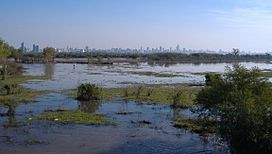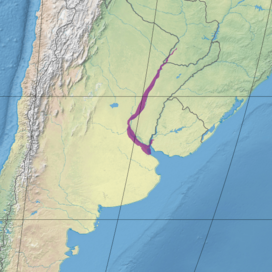Paraná flooded savanna facts for kids
Quick facts for kids Paraná flooded savanna (NT0908) |
|
|---|---|

|
|

Ecoregion territory (in purple)
|
|
| Ecology | |
| Realm | Neotropical |
| Biome | flooded grasslands and savannas |
| Borders | Argentine Espinal, Humid Chaco, and Humid Pampas |
| Geography | |
| Area | 38,850 km2 (15,000 sq mi) |
| Countries | Argentina and Paraguay |
| Coordinates | 29°27′22″S 59°37′05″W / 29.456°S 59.618°W |
| Climate type | Cfa: warm temperate, fully humid, hot summer |
| Conservation | |
| Conservation status | Critical/endangered |
The Paraná flooded savanna (NT0908) is a special ecoregion found along the southern Paraná River in Argentina. It's a place where the land often gets covered by water, creating a unique environment. Sadly, much of this area has been changed for farming or cities. But some small parts of its original habitat still exist near the river.
Contents
Where is the Paraná Flooded Savanna?
This ecoregion covers a huge area of about 3.8 million hectares (that's about 9.4 million acres!). It stretches along the Paraná River valley. You can find it from Resistencia, Chaco in the north all the way south to Buenos Aires.
The Paraná flooded savanna includes the wide floodplains of the middle and lower Paraná River. It also covers areas around the Paraguay River, which is a major river that flows into the Paraná. In the south, it reaches the Paraná delta and the Río de la Plata basin. This long strip of land passes through other ecoregions like the Humid Chaco and the Humid Pampas.
What is the Land Like?
This region has wide, flat coastal areas and low islands. These areas often get flooded by the rivers. The large amounts of water in the rivers and wetlands make the air very humid. This also helps to keep the daily and yearly temperatures from getting too extreme.
The climate here is called "Cfa" by scientists. This means it's a warm temperate zone with lots of rain and hot summers. For example, in one spot, the average yearly temperature is about 19 degrees Celsius (66 degrees Fahrenheit). July is the coolest month, averaging about 12.4 degrees Celsius (54 degrees Fahrenheit). January is the warmest, with an average of 25.4 degrees Celsius (78 degrees Fahrenheit). The area gets about 1,100 millimeters (43 inches) of rain each year. The rainiest month is March, and the driest is July.
Amazing Nature of the Paraná Savanna
The Paraná flooded savanna is part of the Neotropical realm. This means it's in the part of the world that includes Central and South America. It's also a type of flooded grasslands and savannas biome. Long ago, this ecoregion was one of the biggest wetland and river habitats in all of South America!
Plants of the Flooded Savanna
The plants here are typical of Argentina's wet, subtropical northern regions. You can find narrow strips of forest and shrubs on higher ground that rises out of the water. On the islands, there are scrub bushes and grassy areas. Near the river banks and in the water channels, you'll see plants that love water. There are also lagoons within the islands with their own special plants.
Some common trees include Salíx humboldtiana, Tessaria integrifolia, and Erythrina crista-galli (also known as the cockspur coral tree). Water plants are also very important. These include species from the Eichhornia and Paederia groups. You might also spot the giant water lily Victoria cruziana, Cyperus giganteus, Typha latifolia, Typha domingensis, and Pontederia lanceolata.
Animals of the Flooded Savanna
This ecoregion is home to a huge variety of animals!
Mammals in the Wetlands
Many mammals live here. Some examples are the agile gracile opossum (Gracilinanus agilis), the coypu (Myocastor coypus), and the Argentine swamp rat (Scapteromys aquaticus).
Reptiles and Amphibians
Reptiles you might see include the leopard keelback (Helicops leopardinus) and common green racer (Philodryas aestiva) snakes. There are also turtles like Hilaire’s toadhead turtle (Phrynops hilarii) and the Argentine snake-necked turtle (Hydromedusa tectifera). The Venezuela snouted treefrog (Scinax x-signatus) is also found here.
Rare and Endangered Species
Some animals in this area are rare or endangered. These include the polka-dot tree frog (Hypsiboas punctatus), the marsh deer (Blastocerus dichotomus), the neotropical otter (Lontra longicaudis), and the capybara (Hydrochoerus hydrochaeris). Endangered amphibians include the blunt-headed salamander (Ambystoma amblycephalum) and the red-spotted Argentina frog (Argenteohyla siemersi).
Birds of the Savanna
The Paraná flooded savanna is a great place for birds. You can find the biguá (Phalacrocórax olivaceus), rufescent tiger heron (Tigrisoma lineatum), and striped owl (Pseudoscops clamator). Other birds include the green kingfisher (Chloroceryle americana), great black hawk (Buteogallus urubitinga), and roadside hawk (Rupornis magnirostris). You might also spot the dusky-legged guan (Penelope obscura), checkered woodpecker (Veniliornis mixtus), greater thornbird (Phacellodomus ruber), rufous-bellied thrush (Turdus rufiventris), and straight-billed reedhaunter (Limnoctites rectirostris).
Some birds here are endangered, like the yellow cardinal (Gubernatrix cristata), Chaco eagle (Buteogallus coronatus), and Eskimo curlew (Numenius borealis).
Fish and Other Aquatic Life
More than 300 types of fish live in these waters. Most of them are Characiformes and catfish. Some fish are popular for sports fishing, attracting tourists. These include the spotted sorubim (Pseudoplatystoma corruscans), barred sorubim (Pseudoplatystoma fasciatum), paulicea Amazon catfish (Paulicea lutkeni), dorado (Salminus brasiliensis), and pirapitá (Brycon orbiginianus).
Other animals are valued for their economic uses. The streaked prochilod (Prochilodus lineatus) fish is one example. Pearly clams are used for ornaments. Animals like the coypu, neotropical otter, capybara, caiman species, and gold tegu (Tupinambis teguixi) are sometimes used for their skins and hides, and sometimes for their meat.
Current Status and Conservation
The World Wildlife Fund (WWF) has given the Paraná flooded savanna a status of "Critical/Endangered." This means it's in serious trouble. A lot of the original habitat has been turned into farms or city areas. Only small, hard-to-reach patches of the original environment remain along the river.
There are some protected areas trying to save parts of this ecoregion. These include the Cayastá Provincial Reserve, Del Medio-Los Caballos Provincial Reserve, Colonia Benitez Strict Natural Reserve, and Vire-Pitá Provincial Reserve.
The biggest threats to this area come from dams and levees, which change how the rivers flow and flood. Growing cities, pollution, and illegal hunting for animal skins are also big worries for the future of the Paraná flooded savanna.
Sources
See also
 In Spanish: Sabana inundable del Paraná para niños
In Spanish: Sabana inundable del Paraná para niños

